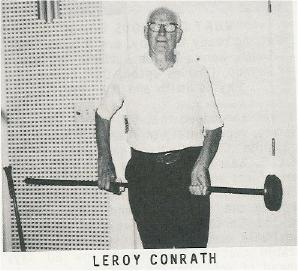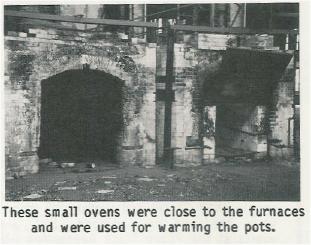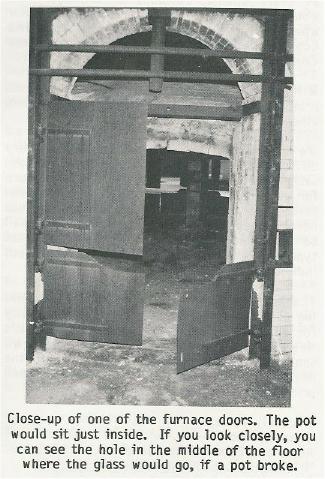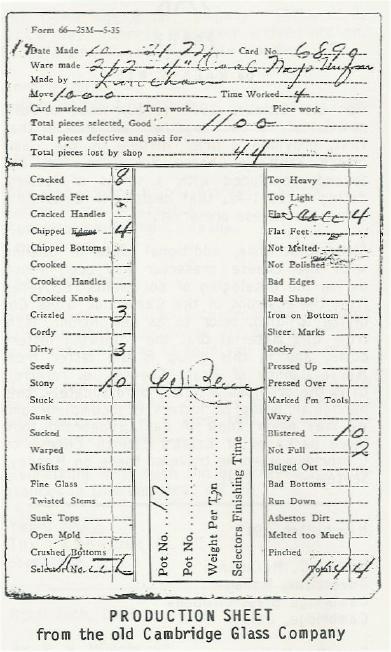National Cambridge Collectors, Inc.
A non-profit 501(c)(3) organization.

Worker of the Month, Leroy Conrath
by Cindy Arent - Issue #221 September 1991
It has been several months since the Cordials Study Group has
been able to interview a former worker of the Cambridge Glass
 Company. However, because of the Workers Reunion, during
Convention, we were very fortunate to interview and video tape,
two brothers, Leroy and Harold Conrath, from the hot metal
department. Since we taped two workers, we will make the most of
it and split the article into two parts. This month's article
will describe a few of the jobs that Leroy did in the hot metal
department, and next month we will hear from his younger brother,
Harold.
Company. However, because of the Workers Reunion, during
Convention, we were very fortunate to interview and video tape,
two brothers, Leroy and Harold Conrath, from the hot metal
department. Since we taped two workers, we will make the most of
it and split the article into two parts. This month's article
will describe a few of the jobs that Leroy did in the hot metal
department, and next month we will hear from his younger brother,
Harold.
The Conrath family moved to Cambridge from Marietta, Ohio, with the specific purpose of working at the Cambridge Glass Company. Leroy's father had already been a glass worker at a glass plant in Marietta. He mentioned that Orie Mosser, foreman of the hot metal department, had also moved to Cambridge from Marietta and that other workers had come from Findlay, Ohio.
1923 was the year that Leroy began working at the Cambridge Glass Company. He worked part-time for two summers until his 16th birthday, when Orie Mosser sent him home at noon to get his birth certificate. He was employed full-time after that.
 One of Leroy's first jobs was holding paste or "water" molds
for the blowers in a vase shop. He later moved up to the more
skilled position of gatherer. The largest pieces of ware that he
remembers gathering were the Swan punch bowl and the Cascade
punch bowl. It took two gatherers with different sized rods to
gather the Swan punch bowl. The first man would gather about nine
or ten pounds of glass, while the second would only gather enough
for the neck and head.
One of Leroy's first jobs was holding paste or "water" molds
for the blowers in a vase shop. He later moved up to the more
skilled position of gatherer. The largest pieces of ware that he
remembers gathering were the Swan punch bowl and the Cascade
punch bowl. It took two gatherers with different sized rods to
gather the Swan punch bowl. The first man would gather about nine
or ten pounds of glass, while the second would only gather enough
for the neck and head.
Leroy also mentioned that he worked "on the floor," for five
or six years, tending the furnaces. He described in detail how
the new pots for the furnaces would arrive on the box cars and
how they were carefully unloaded and prepared for use. Before
each pot could be used, he would glaze the inside with glass
using a long bent rod. Orie Mosser would personally check each
 pot to be sure that the entire interior had been glazed and then
they would ladle out the excess glass. The pot then had to be
warmed in one of the mold ovens before being placed in the
furnace for use. Leroy also said that if a pot would break while
in the furnace, the men downstairs would turn on a special burner
so that the glass could flow more easily down to the basement
through a hole in the furnace floor. When the glass cooled,
the labor crew would use picks to break it
up and haul it to the dump.
pot to be sure that the entire interior had been glazed and then
they would ladle out the excess glass. The pot then had to be
warmed in one of the mold ovens before being placed in the
furnace for use. Leroy also said that if a pot would break while
in the furnace, the men downstairs would turn on a special burner
so that the glass could flow more easily down to the basement
through a hole in the furnace floor. When the glass cooled,
the labor crew would use picks to break it
up and haul it to the dump.
If a pot would crack during use, many times, Leroy would attempt to repair it through a process he called "muddying it up." He would go in Saturday morning and cover the damaged area with mud. Then, using a broom, he would cover the mud with whitewash which made it hard.
It is impossible to include all of the information that Leroy shared with us. He brought one of his "Production Sheets" to the interview. As you can see (below), he and his shop made 1144 pieces of ware in four hours. Of these pieces, only 44 were discarded by the selector.
This sheet is very interesting because of the various terms
used by the company to describe the bad pieces. I think that my
 favorite is "flat feet." Leroy has donated this production sheet
to our Museum, along with a small calendar book with the
Cambridge Glass logo on it. The company gave out these books and
Leroy used his to mark down a variety of information, from
tallies of ware made and workers names, to scores of horseshoe
games.
favorite is "flat feet." Leroy has donated this production sheet
to our Museum, along with a small calendar book with the
Cambridge Glass logo on it. The company gave out these books and
Leroy used his to mark down a variety of information, from
tallies of ware made and workers names, to scores of horseshoe
games.
Leroy continued to work at the Cambridge Glass Company until the final closing, and then went on to work at the Variety Glass Company. He has may interesting facts and stories to share. The tapes will be available at the Museum in the near future.